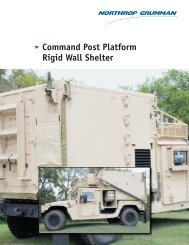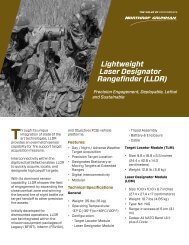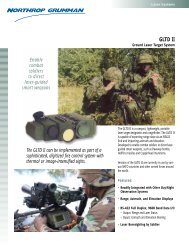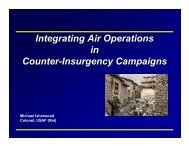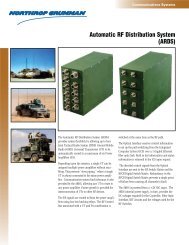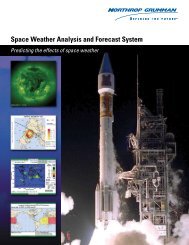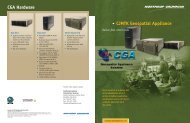Brochure - Northrop Grumman Corporation
Brochure - Northrop Grumman Corporation
Brochure - Northrop Grumman Corporation
You also want an ePaper? Increase the reach of your titles
YUMPU automatically turns print PDFs into web optimized ePapers that Google loves.
User-friendly operator controls<br />
The AN/TPS-78 and TPS-703 provide<br />
two operator control stations with<br />
liquid-crystal flat-panel displays. The<br />
radars can also be operated by remote<br />
control, permitting unattended operation.<br />
The operator control stations provide<br />
the control menus, the airspace<br />
surveillance picture, Built-in Test/Fault<br />
Isolation Test (BIT/FIT) information<br />
and electronic manuals. An onboard<br />
GPS automatically selects the local<br />
area map from the built-in worldwide<br />
map coverage.<br />
Command and control operations can be<br />
performed within the shelter or remotely<br />
from a network command center.<br />
Extended operability<br />
Solid-state transmitters combine the<br />
outputs of many ultra-high reliability<br />
solid-state modules. These modules are<br />
inserted into identical, interchangeable<br />
power panels. Full radar coverage does<br />
not require all of the solid-state modules<br />
to be operating at once. Sufficient<br />
margin is provided in the transmitter<br />
such that advertised performance can<br />
easily be maintained, even with the normal<br />
rate of failing transistors, until the<br />
next scheduled maintenance interval.<br />
This ‘“Fail Soft” design eliminates the<br />
need for immediate repair of transmitter<br />
hardware.<br />
Additionally, the AN/TPS-78 and the<br />
TPS-703 do not require transmit/receive<br />
(T/R) modules on the rotating antenna.<br />
Thus there is no risk of holes in<br />
the radar coverage pattern due to failed<br />
T/R modules. Because there are no active<br />
radiating antennas, the systems are<br />
not as vulnerable to infrared-guided<br />
weapons, and there is no need to stop<br />
operations to replace failed T/R modules,<br />
giving both systems extended operability.<br />
Technological and design<br />
enhancements<br />
Solid-state transmitters for both the AN/<br />
TPS-78 and TPS-703 include the latest<br />
in <strong>Northrop</strong> <strong>Grumman</strong>’s technological<br />
enhancements, including use of highefficiency<br />
silicon germanium power<br />
transistors, which provide higher transmitter<br />
reliability in a more compact design.<br />
The growth in the system bandwidth<br />
from 200 to 300 MHz relative to<br />
previous generations of radars provides<br />
for increased Electromagnetic Counter<br />
Countermeasures (ECCM) performance.<br />
Both systems have complete<br />
range and elevation Doppler coverage<br />
for target detection in ground, weather<br />
and chaff clutter.<br />
GPS time synchronization supports<br />
network-centric radar operation, allowing<br />
for more sophisticated target<br />
tracking capability among collaborating<br />
radar systems. System electronics,<br />
including the transmitter, are contained<br />
in the environmentally controlled shelter,<br />
both for ease of maintenance and<br />
for protection of the electronics.<br />
Unrivaled Mobility<br />
S-Band provides compact<br />
system size<br />
S-Band technology provides longrange<br />
performance in the AN/TPS-78<br />
and TPS-703, while also resulting in a<br />
significantly smaller antenna and shelter<br />
volume. All electronics including<br />
the transmitter are packaged in a single<br />
14-foot (4.3 m) International Organization<br />
for Standardization (ISO) shelter,<br />
among the smallest manned shelters<br />
in use. The AN/TPS-78 and the TPS-<br />
2<br />
703 can each be transported in a single<br />
C-130 aircraft. They can also be transported<br />
locally via helicopter or by a<br />
single truck with a mobilizer.<br />
An integrated Identification Friend or<br />
Foe (IFF) antenna in the main antenna<br />
assembly eliminates the need for a separate<br />
IFF antenna alignment, thereby<br />
minimizing system setup time. The<br />
antenna also has a built-in inertial measurement<br />
unit for fast leveling. With<br />
no special tools or equipment required,<br />
it takes a four-person team less than 30<br />
minutes to set up or disassemble either<br />
the long-range AN/TPS-78 or the midrange<br />
TPS-703. These radar systems<br />
can be moved faster than adversaries<br />
can target them.<br />
The antenna ISO pallet can be transported<br />
and deployed on a standard 5-ton truck.<br />
The ISO shelter is 14 feet and 33 percent<br />
shorter than other radars in its class.<br />
The entire radar suite (generator, spares,<br />
shelter and antenna) can be transported<br />
on a single C-130 load.


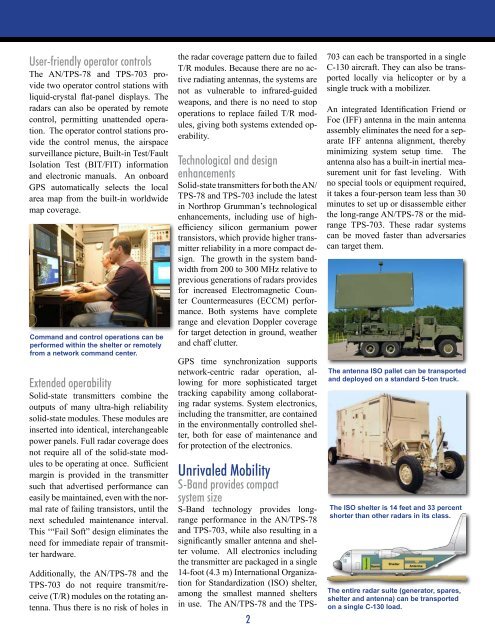
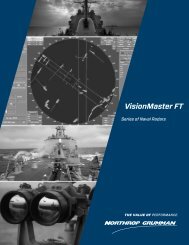
![[x] amendment of solicitation/modification of contract - Northrop ...](https://img.yumpu.com/51622731/1/190x245/x-amendment-of-solicitation-modification-of-contract-northrop-.jpg?quality=85)
